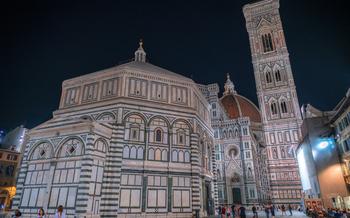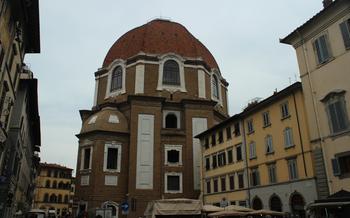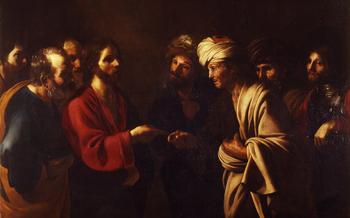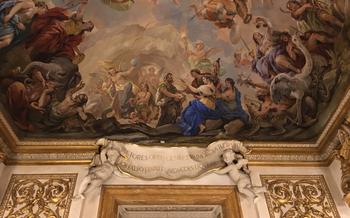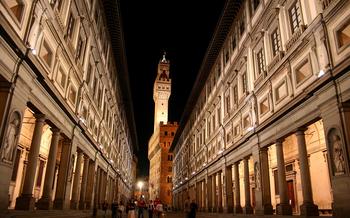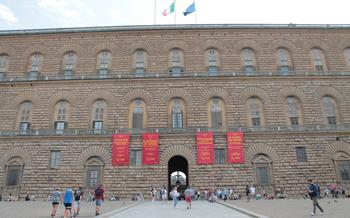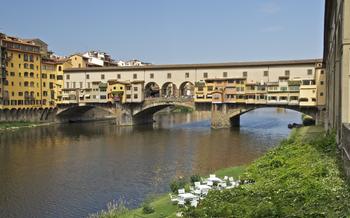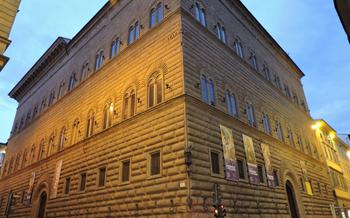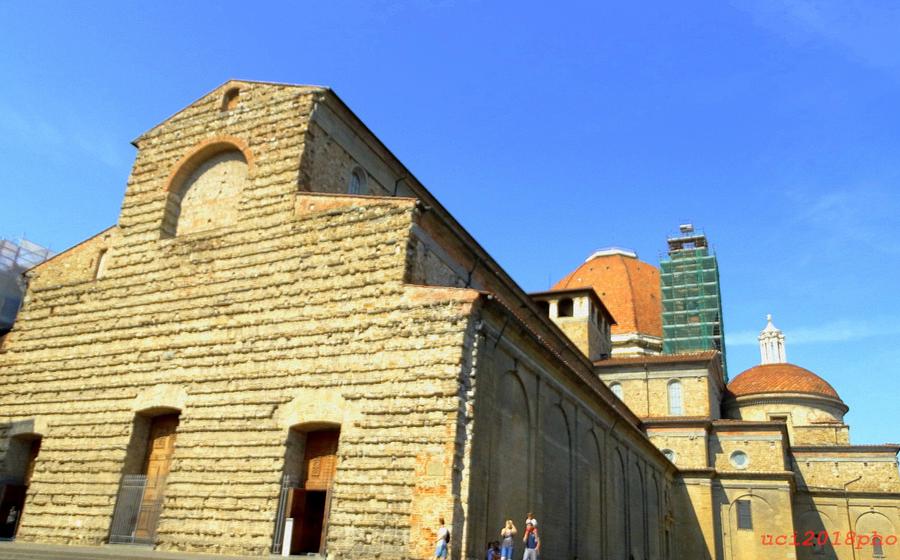
San Lorenzo Church
- The San Lorenzo Church: A Florentine Masterpiece
- History: A Tapestry of Architectural Evolution
- Architecture: A Symphony of Grace and Grandeur
- Art and Treasures: A Gallery of Divine Beauty
- Significance: A Symbol of Faith, Power, and Artistic Mastery
- The Medici Chapels: Opulent Symbol of Medici Power
- The Basilica of San Lorenzo
- The Medici Tombs: Symbols of Power and Artistic Patronage
- The Chiostro di San Lorenzo
- The Laurentian Library: A Treasure Trove of Knowledge
- The Medici Villas: Palaces of Power and Leisure
- San Lorenzo Market: A Feast for the Senses
- The Palazzo Medici Riccardi
- The Bargello Museum
- The Museo di Palazzo Vecchio
- The Uffizi Gallery: A Treasure Trove of Renaissance Art
- The Accademia Gallery: Michelangelo's Masterpieces
- Insider Tip: The Secret Medici Garden
The San Lorenzo Church: A Florentine Masterpiece
In the heart of Florence, amidst the bustling streets and architectural wonders, stands the imposing San Lorenzo Church, a testament to the city's rich history and artistic legacy. Founded in the 4th century, the church has undergone numerous transformations over the centuries, each leaving its mark on the building's intricate facade and opulent interior.
History: A Tapestry of Architectural Evolution
The church's origins date back to the 4th century, when it was a simple basilica dedicated to Saint Lawrence. Over the centuries, it underwent several renovations and expansions, culminating in the magnificent structure we see today. In the 15th century, the Medici family, prominent patrons of the arts, commissioned the renowned architect Filippo Brunelleschi to redesign and rebuild the church. Brunelleschi's elegant and harmonious design transformed San Lorenzo into one of the earliest examples of Renaissance architecture.
Architecture: A Symphony of Grace and Grandeur
The exterior of the church is characterized by its simple yet striking facade, adorned with intricate carvings and sculptures. The interior, however, is a breathtaking display of architectural prowess. Brunelleschi's innovative use of columns, arches, and barrel vaults creates a sense of spaciousness and luminosity that is both awe-inspiring and serene. The church's harmonious proportions and elegant lines embody the ideals of Renaissance architecture, making it a masterpiece of the era.
Art and Treasures: A Gallery of Divine Beauty
San Lorenzo is not just an architectural marvel but also a treasure trove of artistic riches. The church is home to numerous artworks, including sculptures, paintings, and relics of immense historical and cultural significance. The most notable works include Donatello's bronze pulpits, which showcase the artist's mastery of perspective and human anatomy, and the Medici Chapels, an opulent complex filled with sculptures and frescoes by some of the most renowned artists of the Renaissance.
Significance: A Symbol of Faith, Power, and Artistic Mastery
The San Lorenzo Church holds a profound significance in Florence's cultural and religious landscape. As one of the city's oldest and most important churches, it has been a place of worship, pilgrimage, and artistic patronage for centuries. The church's association with the Medici family further enhances its importance, as it served as their family church and a symbol of their political power and artistic legacy. San Lorenzo stands as a testament to Florence's unwavering devotion to faith, love for the arts, and commitment to preserving its rich cultural heritage.
The Medici Chapels: Opulent Symbol of Medici Power
The Medici Chapels, adjacent to the San Lorenzo Church, stand as a testament to the Medici family's power, wealth, and patronage of the arts. Commissioned by Cosimo I de' Medici in the 16th century, the chapels were designed by some of the most renowned architects and artists of the Renaissance, including Michelangelo and Giorgio Vasari.
The chapels' exteriors feature intricate stone carvings and sculptures, while the interiors boast lavish decorations, frescoes, and elaborate tombs. The most notable feature of the chapels is the New Sacristy, designed by Michelangelo, which houses the tombs of Giuliano de' Medici, Duke of Nemours, and Lorenzo de' Medici, Duke of Urbino.
These tombs showcase Michelangelo's mastery of sculpture, with their lifelike figures and intricate details. The New Sacristy also features the famous "Madonna and Child" sculpture by Michelangelo, considered one of his finest works.
The Medici Chapels are a must-see for anyone interested in art, history, or the Medici family. They offer a glimpse into the opulence and grandeur of the Medici era and provide a deeper understanding of their contributions to the cultural and artistic heritage of Florence.
The Basilica of San Lorenzo
The Basilica of San Lorenzo, a prominent religious site in Florence, stands as a testament to the city's rich history and architectural prowess. Constructed in the 4th century, the basilica has undergone numerous modifications and expansions over the centuries, reflecting the city's evolving religious and cultural landscape.
In the 11th century, the basilica was significantly enlarged and took on a Romanesque architectural style. This transformation introduced distinctive features such as rounded arches, thick walls, and a spacious interior. The basilica's façade, adorned with intricate carvings and sculptures, showcases the artistic talents of the era.
The interior of the basilica is a treasure trove of significant artworks and relics. The most notable is the Cappella dei Principi, a lavishly decorated chapel commissioned by the Medici family. This opulent chapel houses the remains of several Medici rulers and is adorned with intricate marble sculptures, vibrant frescoes, and gold leaf decorations.
Beyond the Cappella dei Principi, the basilica boasts other notable artworks, including exquisite stained glass windows, intricate mosaics, and paintings by renowned Renaissance masters such as Filippino Lippi and Bronzino. The basilica's grandeur and historical significance continue to draw visitors and pilgrims from around the world, making it a must-visit destination for anyone exploring Florence's religious and cultural heritage.
The Medici Tombs: Symbols of Power and Artistic Patronage
The Medici Tombs, located within the Medici Chapels, are elaborate mausoleums that serve as a testament to the Medici family's power and wealth. Constructed during the Renaissance, these tombs showcase the family's patronage of the arts and their desire to leave a lasting legacy. The most notable tombs include that of Cosimo I de' Medici, Grand Duke of Tuscany, by Bartolomeo Ammannati, which features a grand sarcophagus adorned with allegorical figures. Another impressive tomb is that of Ferdinando I de' Medici by Gianbologna, which boasts a bronze statue of the Grand Duke on horseback.
The tombs are not merely decorative but also convey political and religious messages. The sculptures and inscriptions on the tombs celebrate the Medici's achievements, their alliances with the Catholic Church, and their role as patrons of the arts. The tombs also serve as a reminder of the Medici's mortality and their desire for eternal glory.
As visitors admire the Medici Tombs, they are transported back in time to the Renaissance, a period of great artistic and political ferment. The tombs offer a glimpse into the lives and ambitions of the Medici family, who played a pivotal role in shaping the history and culture of Florence.
Here are some additional details about the Medici Tombs:
- The tombs were commissioned by Cosimo I de' Medici in the 16th century.
- The tombs are made of various materials, including marble, bronze, and porphyry.
- The tombs are decorated with sculptures, paintings, and inscriptions.
- The tombs are open to the public and can be visited as part of a tour of the Medici Chapels.
The Chiostro di San Lorenzo
Adjacent to the basilica lies a serene oasis cloister served as a contemplative retreat for monks and a place of learning for students. Its architectural style exudes a harmonious blend of Gothic and Renaissance elements, creating an atmosphere of tranquility and elegance.
The Chiostro di San Lorenzo boasts an array of notable frescoes and sculptures that adorn its walls and lunettes. Among these artistic treasures, visitors can admire the delicate brushstrokes of Fra Angelico's frescoes, depicting scenes from the life of Saint Francis. The cloister also houses several sculptures by Donatello, including his renowned bronze statue of Saint George, a masterpiece that captures the essence of power and determination.
The Chiostro di San Lorenzo stands as a testament to the harmonious coexistence of art and spirituality. As visitors stroll through its tranquil arcades, they are transported to a bygone era, where monks sought solace and scholars pursued knowledge within these sacred walls. The cloister remains a hidden gem, offering respite from the bustling streets of Florence and inviting travelers to immerse themselves in the serenity of this architectural and artistic wonder.
The Laurentian Library: A Treasure Trove of Knowledge
Adjacent to the San Lorenzo Church, the Laurentian Library stands as a testament to the Medici family's enduring legacy of patronage and scholarship. Founded by Cosimo de' Medici in the 15th century, the library was conceived as a private collection for the exclusive use of the Medici family and their guests.
Over the years, the library's collection grew exponentially, attracting scholars and bibliophiles from across Europe. In the 16th century, Grand Duke Cosimo I commissioned Michelangelo to design a new reading room for the library. Michelangelo's innovative design, characterized by its elegant staircase and wooden reading desks, revolutionized library architecture and set a new standard for scholarly spaces.
Today, the Laurentian Library houses an impressive collection of rare books and manuscripts, including works by Homer, Virgil, and Dante. The library's collection is particularly rich in illuminated manuscripts, many of which were commissioned by the Medici family themselves.
As one of the most important libraries in the world, the Laurentian Library continues to attract scholars and visitors alike. Its unique architecture, combined with its invaluable collection, makes it a must-visit destination for anyone interested in the history of books, the Renaissance, or the Medici family.
The Medici Villas: Palaces of Power and Leisure
Beyond the confines of Florence, the Medici family's influence extended to the surrounding countryside, where they established a network of magnificent villas. These palatial retreats served as symbols of Medici power and wealth, while also providing respite from the bustling city life.
Scattered throughout the Tuscan landscape, the Medici villas showcased a diverse range of architectural styles, reflecting the evolving tastes and preferences of the family over time. From the elegant simplicity of Villa Medici at Fiesole to the opulent grandeur of Villa della Petraia, each villa bore the hallmarks of Medici patronage and refined taste.
Beyond their architectural splendor, the Medici villas were also renowned for their exquisite gardens, which showcased the family's passion for botany and horticulture. These verdant havens, designed by renowned landscape architects, featured a rich variety of plants, flowers, and sculptures, creating a harmonious blend of nature and art.
For the Medicis, the villas were not merely places of leisure and relaxation, but also centers of intellectual and cultural pursuits. They hosted lavish banquets, theatrical performances, and literary gatherings, attracting artists, scholars, and dignitaries from across Europe. Within the walls of these palatial retreats, the Medicis cultivated their patronage of the arts and sciences, contributing to the flourishing of the Florentine Renaissance.
Today, many of the Medici villas are open to the public, offering visitors a glimpse into the lives and legacy of this influential family. These architectural treasures, set amidst the rolling hills of Tuscany, continue to captivate visitors with their beauty, history, and the enduring spirit of the Medici dynasty.
San Lorenzo Market: A Feast for the Senses
In the heart of Florence, amidst the historic streets surrounding the San Lorenzo Church, lies a bustling marketplace that has stood the test of time: the San Lorenzo Market. Its origins can be traced back to the 14th century when merchants and artisans gathered here to showcase their wares. Over the centuries, the market has evolved into a vibrant hub of commerce, offering a diverse array of goods and experiences.
As you approach the market, the air fills with a symphony of sounds and scents. Vendors extol the virtues of their fresh produce, while the aroma of mouthwatering street food wafts through the air. Rows upon rows of stalls line the narrow streets, each displaying a treasure trove of goods. From colorful fruits and vegetables to handmade leather goods, and souvenirs that celebrate the city's rich heritage, there's something for every taste and budget.
The market is not just a place of commerce; it's a living tapestry of Florentine culture. Locals and tourists alike mingle in the bustling aisles, bargaining with vendors, sharing laughter, and exchanging stories. The atmosphere is electric, a testament to the market's enduring popularity.
Whether you're looking for a unique souvenir to take home, a delicious snack to refuel your explorations, or simply a chance to soak up the local flavor, the San Lorenzo Market is a must-visit destination. As you wander through the maze-like streets, take the time to engage with the friendly vendors, sample some of the local delicacies, and let the vibrant energy of this historic marketplace wash over you.
The Palazzo Medici Riccardi
Adjacent to the San Lorenzo Church stands the Palazzo Medici Riccardi, a magnificent palace that epitomizes the Medici family's power and wealth. Commissioned by Cosimo de' Medici in the 15th century, the palace was designed by Michelozzo di Bartolomeo and is considered a masterpiece of Renaissance architecture.
The Palazzo Medici Riccardi boasts an elegant and harmonious facade, characterized by its rusticated stonework, arched windows, and a prominent cornice. Inside, the palace is adorned with stunning frescoes by Benozzo Gozzoli, depicting scenes from the life of the Medici family. The palace also houses a collection of valuable artworks, including sculptures, paintings, and tapestries, which offer a glimpse into the Medici family's refined taste and patronage of the arts.
Beyond its architectural and artistic significance, the Palazzo Medici Riccardi holds great historical importance. It served as the Medici family's primary residence in Florence until the 16th century and witnessed many significant events that shaped the city's history. Today, the palace is open to the public as a museum, allowing visitors to immerse themselves in the opulent world of the Medici and experience the grandeur of their architectural legacy.
The Bargello Museum
The Bargello Museum is a captivating museum situated in the heart of Florence, a stone's throw away from the San Lorenzo Church. Housed within a former Palazzo del Podestà, the museum's history is as rich and intriguing as the collection it holds. Originally constructed in the 13th century as the seat of Florence's chief magistrate, the Palazzo del Podestà underwent several transformations over the centuries, serving as a prison, an armory, and a police headquarters before finally finding its purpose as a museum in the 19th century.
The Bargello Museum is renowned for its exceptional collection of Renaissance sculptures, considered one of the finest in the world. The museum's galleries are adorned with masterpieces by legendary artists such as Donatello, Michelangelo, and Giambologna. Among the highlights of the collection is Donatello's exquisite bronze statue of David, which revolutionized the depiction of the biblical hero and set a new standard for Renaissance sculpture.
Another highlight is Michelangelo's unfinished masterpiece, the Bacchus, which showcases the artist's mastery of anatomy and movement. The museum also boasts an impressive collection of works by Benvenuto Cellini, including his delicate and intricate bronze sculpture of Perseus with the Head of Medusa.
The Bargello Museum is not just a repository of Renaissance sculptures; it is a journey through the history of Florence. The building itself, with its imposing facade and medieval tower, tells the story of the city's political and social evolution. The sculptures, each a testament to the skill and creativity of the Renaissance masters, provide a glimpse into the cultural and artistic flourishing of that era.
A visit to the Bargello Museum is a must for any art enthusiast or history buff. Its collection of Renaissance sculptures is unparalleled, and the atmosphere within the museum's historic walls is truly captivating. The Bargello Museum is a treasure trove of artistic wonders, offering a profound insight into the creative genius of the Renaissance period.
The Museo di Palazzo Vecchio
Immerse yourself in the heart of Florentine history and art at the Museo di Palazzo Vecchio. Housed within the Palazzo Vecchio, the former seat of Florence's government, this museum offers a captivating journey through the city's rich past.
As you wander through the grand halls and intimate chambers, admire an eclectic collection of artworks, spanning from the Middle Ages to the Renaissance and beyond. Paintings, sculptures, tapestries, and decorative arts adorn the walls, each piece telling a story of Florence's artistic heritage.
Among the highlights of the collection is the stunning "Battle of Cascina" by Michelangelo, a preparatory drawing for a fresco that was never completed. The intricate details and powerful figures in this drawing showcase Michelangelo's mastery and genius.
Another must-see is the "Studiolo of Francesco I de' Medici," a small room decorated with exquisite paintings and sculptures that offer a glimpse into the private world of the Medici family, who ruled Florence for centuries.
The Museo di Palazzo Vecchio is not merely a museum; it is a testament to Florence's enduring legacy as a center of art, politics, and culture. With each step you take through its halls, you'll discover the stories and secrets that have shaped this extraordinary city.
The Uffizi Gallery: A Treasure Trove of Renaissance Art
Nestled amidst the historic heart of Florence, the Uffizi Gallery stands as a testament to the city's rich artistic legacy. Once the administrative offices of the Medici family, this magnificent building now houses one of the world's most renowned art museums, attracting millions of visitors each year.
History: The Uffizi Gallery's origins can be traced back to the ambitious vision of Cosimo I de' Medici, the first Grand Duke of Tuscany. In 1560, he commissioned the construction of a new building to accommodate the rapidly expanding collection of Medici treasures. Designed by Giorgio Vasari, the building's construction spanned several decades, reflecting the Medici's growing power and influence.
Collection: The Uffizi Gallery boasts a staggering collection of Renaissance and Baroque masterpieces, representing the golden age of Italian art. Visitors can marvel at the exquisite works of Botticelli, whose "Birth of Venus" and "Primavera" are among the gallery's most iconic paintings. Michelangelo's "Doni Tondo," a rare example of his panel painting, is another highlight, as is Raphael's "Madonna of the Goldfinch," renowned for its serene beauty.
Highlights: Beyond these iconic works, the Uffizi Gallery offers a treasure trove of artistic wonders. Caravaggio's "Bacchus" captivates with its realism and dramatic lighting, while Titian's "Venus of Urbino" exudes sensuality and elegance. The gallery also houses an impressive collection of self-portraits by renowned artists, providing a unique glimpse into the minds and styles of these creative masters.
Significance: The Uffizi Gallery stands as a testament to the Medici family's discerning taste and their patronage of the arts. The gallery's vast collection offers a comprehensive journey through the Italian Renaissance, showcasing the evolution of artistic styles and techniques. Its significance extends far beyond Florence, as it is considered one of the most important art museums in the world, attracting art enthusiasts and scholars from around the globe.
The Accademia Gallery: Michelangelo's Masterpieces
The Accademia Gallery, located in the heart of Florence, stands as a testament to the genius of Michelangelo Buonarroti. Founded in 1784 by the Grand Duke of Tuscany, Pietro Leopoldo, the gallery initially served as an educational institution for aspiring artists. Today, it has evolved into one of the world's most renowned museums, primarily dedicated to the works of Michelangelo, whose sculptures have captivated art enthusiasts for centuries.
At the heart of the gallery's collection lies Michelangelo's iconic masterpiece, the David. Carved from a single block of Carrara marble between 1501 and 1504, the 17-foot-tall statue exudes an unparalleled sense of strength, beauty, and defiance. The intricate details and lifelike expressions of David have made it an enduring symbol of Renaissance art and an enduring emblem of Florence.
Another highlight of the Accademia Gallery is Michelangelo's unfinished Pietà, a poignant depiction of the Virgin Mary cradling the body of Jesus after his crucifixion. While the Pietà remains incomplete, its unfinished state offers a unique glimpse into Michelangelo's creative process, revealing his masterful chisel work and the emotional depth he imbued in his sculptures.
Beyond Michelangelo's masterpieces, the Accademia Gallery also houses a notable collection of paintings, sculptures, and drawings by other prominent artists of the Renaissance period, including Sandro Botticelli, Domenico Ghirlandaio, and Pontormo. The gallery's diverse collection provides a comprehensive overview of the artistic achievements of Florence during the Renaissance, making it a must-visit destination for art enthusiasts and history buffs alike.
Insider Tip: The Secret Medici Garden
Tucked away behind the Medici Chapels, the secret Medici Garden offers a tranquil oasis amidst the bustling city. This hidden gem, once used by the Medici family for private gatherings and relaxation, features a lush garden filled with fragrant flowers, towering trees, and intricate sculptures. The serene atmosphere, coupled with stunning views of the city, makes it an ideal spot for a peaceful escape. Discover this hidden gem and immerse yourself in its tranquil beauty, imagining the Medici strolls and conversations that once took place within its walls.
